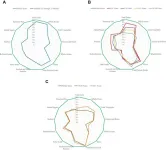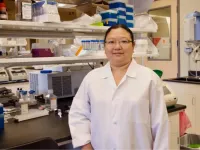(Press-News.org) When we wash our face with a cleanser, our skin can start to feel tight. With the application of a favorite moisturizer, that feeling often goes away. This perception of our skin might seem subjective, but researchers at Stanford recently revealed the mechanism behind these feelings.
Their work, published this week in PNAS Nexus, demonstrates how mechanical changes at the outer surface of our skin translate into sensations and provides a quantitative approach for determining how people will perceive their skin after using a moisturizer or cleanser.
“This work provides a new understanding of how products affect the physical properties of our skin, which includes not just skin health, but also skin sensorial perception. That’s a significant advance,” said Reinhold Dauskardt, the Ruth G. and William K. Bowes Professor in Stanford’s Department of Materials Science and Engineering. “It provides a whole new understanding of how to design those formulations.”
Sensation prediction
Our skin is the largest organ in our body and it’s constantly exposed to the environment around us. The outermost layer of our skin – the stratum corneum – acts as a barrier to keep out unwanted chemicals and bacteria and to keep in moisture. When we use a harsh cleanser, it strips away some of the lipids that hold in moisture, causing the stratum corneum to contract. A good moisturizer increases the water content of the stratum corneum, causing it to swell.
Dauskardt and his colleagues predicted that the mechanical forces created by this shrinking or swelling propagate through the skin to reach mechanoreceptors – sensory receptors that turn mechanical force into neurological signals – below the epidermis, which then fire off signals to the brain that we interpret as a feeling of skin tightness.
To test their theory, the researchers studied the effects of nine different moisturizing formulas and six different cleansers on donor skin samples from three locations on the human body – cheek, forehead, and abdomen. They measured changes in the stratum corneum in the lab and then fed that information into a sophisticated model of human skin to predict the signals that the mechanoreceptors would send.
“We were able to rank the different formulations in terms of what subjects should say about the sensorial perception of their skin,” Dauskardt said.
The predictions from their analysis lined up almost perfectly with what people reported in human trials for each formula. Collaborators at L’Oréal Research and Innovation recruited 2,000 women in France to assess the nine moisturizers and 700 women in China to assess the six cleansers. The participants ranked their perceived feelings of skin tightness after using the formula they were given.
“We plotted what we were predicting against what human subjects were telling us, and it all fell on a straight line. In other words, we were predicting exactly what they were telling us,” Dauskardt said. “It was an absolutely remarkable correlation with a very high statistical significance.”
Shaping new developments
The ability to understand and predict how people will feel after using a skin treatment could help cosmetics companies improve their formulations before bringing in people to test them. And with such a detailed model of how mechanical stresses are transferred through skin layers, these methods could potentially be used to evaluate more than just the feeling of tightness, Dauskardt said.
“It provides a framework for the development of new products,” Dauskardt said. “If you’re doing anything to the outer layer of the skin that’s causing it to change its strain state and its stress state, then we can tell you how that information is transmitted and how it will be understood and reported by consumers.”
Dauskardt is also looking to apply this new understanding to the development of wearable devices. For example, if we know how our brains interpret minute changes in skin tension, we might be able to harness that mechanism to send intentional signals. In the same way that a person reading braille translates sensations on their fingertip into words, a device creating tiny mechanical changes on our skin might be able to convey information.
“What we’ve done is reveal how mechanical information gets from the outer stratum corneum layer down to the neurons much lower in the skin layers,” Dauskardt said. “So now, can we communicate through human skin? Can we build a device to provide information to someone non-verbally, non-visually, using our understanding of these mechanisms? That’s one of the areas we’re very interested in.”
Dauskardt is a member of Stanford Bio-X , the Cardiovascular Institute, the Wu Tsai Human Performance Alliance, and the Wu Tsai Neurosciences Institute, and an affiliate of the Precourt Institute for Energy and the Stanford Woods Institute for the Environment.
Additional Stanford co-authors of this research include doctoral students Ross Bennett-Kennett and Joseph Pace. Other co-authors are from L’Oréal Research and Innovation. This work was funded by L’Oréal Research and Innovation.
END
Research reveals why our skin feels ‘tight’
2023-09-26
ELSE PRESS RELEASES FROM THIS DATE:
World-class neutron source takes a break for major Proton Power Upgrade
2023-09-26
The Spallation Neutron Source at Oak Ridge National Laboratory — already the world’s most powerful accelerator-based neutron source — will be on a planned hiatus through June 2024 as crews work to upgrade the facility.
Much of the work — part of the facility’s Proton Power Upgrade project — will involve building a connector between the accelerator and the planned Second Target Station at SNS. When complete, the PPU project will bring the accelerator up to 2.8 megawatts from its current record-breaking ...
Study sheds new light on strange lava worlds
2023-09-26
COLUMBUS, Ohio – Lava worlds, massive exoplanets home to sparkling skies and roiling volcanic seas called magma oceans, are distinctly unlike the planets in our solar system.
To date, nearly 50% of all rocky exoplanets yet discovered have been found capable of maintaining magma on their surfaces, likely because these planets are so close to their host stars they orbit in fewer than 10 days. Being so close causes the planet to be bombarded by harsh weather and forces surface temperatures to the extreme, making it all but completely inhospitable to life as we know it today.
Now, in a new study, scientists have ...
Latest version of the Healthy Eating Index covers toddler diet quality
2023-09-26
Philadelphia, September 26, 2023 – In four articles in the Journal of Nutrition and Dietetics, published by Elsevier, leading nutrition experts describe and evaluate the latest versions of the Healthy Eating Index (HEI), issued to correspond to the 2020-2025 Dietary Guidelines for Americans (DGA). For the first time, there are two new HEIs, one for children and adults 2 years and older, and one for young children aged 12 through 23 months.
The Call to Action of the ninth edition of the Dietary Guidelines for Americans is “Make Every Bite Count.” These guidelines form the basis of nutrition policy ...
U of M Medical School research team studies homicides of health professionals
2023-09-26
MINNEAPOLIS/ST. PAUL (09/26/2023) — Published in the Journal of Clinical Psychology, University of Minnesota Medical School researchers examined homicide rates of health professionals in the United States to inform prevention interventions and strategies.
The research team used the Centers for Disease Control and Prevention’s National Violent Death Reporting System (NVDRS) to collect data on the number of homicides among ten types of health professionals, including doctors, psychologists, nurses, social workers and pharmacists.
The study found rates of homicides ...
UH researcher on team developing sense-and-respond cancer implant technology
2023-09-26
The Advanced Research Projects Agency for Health (ARPA-H) has awarded $45 million to rapidly develop sense-and-respond implant technology that could slash U.S. cancer-related deaths by more than 50%.
The award to a team of researchers from seven states, led by Rice University, will fast-track development and testing of a first-of-its-kind approach to cancer treatment that aims to dramatically improve immunotherapy outcomes for patients with ovarian, pancreatic and other difficult-to-treat cancers.
Weiyi Peng, assistant professor ...
U of M Medical School receives $16 million to uncover the 'wiring diagram' of the brain
2023-09-26
MINNEAPOLIS/ST. PAUL (09/26/2023) — The University of Minnesota Medical School received a $16 million grant from the National Institutes of Health (NIH) Brain Research Through Advancing Innovative Neurotechnologies® (BRAIN) Initiative to support the groundbreaking project of unraveling the mysteries of the brain's ‘wiring diagram.’ Using cutting-edge techniques, this research aims to discover how the brain's neurons are connected and communicate with each other.
The project aims to better understand how complex neural ...
Arctic sea ice 6th lowest on record; Antarctic sees record low growth
2023-09-26
Arctic sea ice likely reached its annual minimum extent on Sept. 19, 2023, making it the sixth-lowest year in the satellite record, according to researchers at NASA and the National Snow and Ice Data Center (NSIDC). Meanwhile, Antarctic sea ice reached its lowest maximum extent on record on Sept. 10 at a time when the ice cover should have been growing at a much faster pace during the darkest and coldest months.
Scientists track the seasonal and annual fluctuations because sea ice shapes Earth’s polar ecosystems and plays a significant role in global climate. Researchers at NSIDC ...
Van Andel Institute appoints new Graduate School dean and chief academic officer
2023-09-26
GRAND RAPIDS, Mich. (Sept. 26, 2023) — Van Andel Institute has appointed Eric Swindell, Ph.D., as dean and chief academic officer of Van Andel Institute Graduate School, effective Dec. 4, 2023.
Swindell joins the Institute after a distinguished 25-year career in scientific research, with the past several years dedicated to leadership positions in biomedical graduate education. He brings a proven track record as a dynamic, energetic and motivational team builder who possesses a deep understanding of science graduate education and a robust commitment to collaboration and inclusiveness.
“I am excited to join Van Andel Institute and honored to ...
Black bisexual women in rural areas are at highest risk for suicidal behaviors
2023-09-26
HERSHEY, Pa. — Non-Hispanic and Hispanic Black bisexual women who live in rural areas have the highest prevalence of experiencing suicidal thoughts and behaviors, according to a Penn State-led study. The researchers said this “first-of-its-kind study,” published in JAMA Psychiatry, revealed how various demographic factors intersect to affect a person’s risk of having suicidal thoughts and behaviors.
An estimated 12 million adults in the United States think about suicide every year, with nearly two million ...
New material captures coronavirus particles and could transform face mask efficiency
2023-09-26
A research team at the University of Liverpool has developed a new material that captures coronavirus particles and could transform the efficiency of face masks and other filter equipment to stop the spread of COVID-19 and other viruses.
In a paper published in the journal Nature Communications, the team showed that the new material used in a conventional face mask was approximately 93% more efficient at capturing proteins, including coronavirus proteins, with little impact on breathability.
The Liverpool scientists behind the new material are Professor Peter Myers, a research leader in chromatography, and Dr Simon Maher, a mass spectrometry expert.
They had ...





